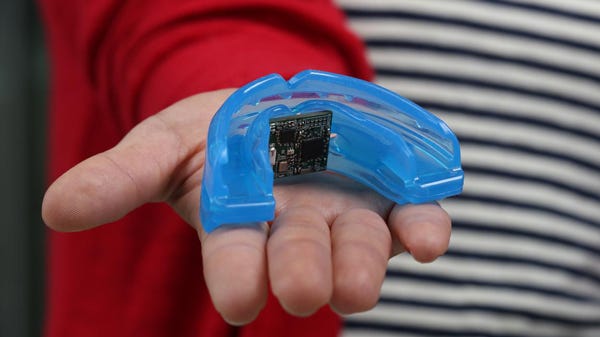A Smart Mouth Guard to Track Health Markers in Real Time
October 1, 2015
Engineers at UC San Diego have built a mouth guard prototype that can monitor health markers such as lactate, cortisol, and uric acid. The technology is designed to transmit health tracking information wirelessly in real time to any smartphone, laptop, or tablet device.
Kristopher Sturgis
|
The key to the smart mouth guard was the use of uricase, an enzyme that specifically reacts with uric acid. (Photo courtesy of UC San Diego) |
UC San Diego researchers have a new smart mouth guard, still in a proof-of-concept stage, designed to help monitor people continuously in a non-invasive manner. The technology could serve as a boon for athletes who look to monitor performance levels in real time, or pilots and soldiers looking to measure stress levels in the field.
While oral sensor technology isn't exactly a new science, this new sensor focuses on uric acid, a valuable health marker that was previously only measurable when drawing blood from a patient. This team of engineers believe that the new mouth guard sensor could offer a simple and reliable method for monitoring uric acid levels in the saliva, and could hold considerable promise for a myriad of different biomedical and fitness applications.
The design of the technology was led by nanoengineering professor Joseph Wang and electrical engineering professor Patrick Mercier. The key to their device was the use of uricase, an enzyme that specifically reacts with uric acid. This proved to be the special ingredient, as human saliva has been shown to be extremely complex with many different biomarkers. When the uricase reacts with the uric acid, it generates hydrogen peroxide, which is detected and transmitted through Prussian blue ink, via electrical signals, to an electronic board with metallic strips.
That electric board uses small chips that sense the output of the sensors, digitizes the information, and then wirelessly transmits the data to a smartphone, tablet, or laptop. The entire electronic board occupies a space slightly larger than a penny. Finally, the electronics are all packaged inside the mouth guard so that it can be safely and effectively worn while in use.
The market for wearable technologies continues to expand as the burgeoning industry looks for new ways to track and monitor health markers, activity levels, and other metrics. Oral sensing technologies have carved out their own unique space in recent years, as we've seen the development of mouthguards that monitor brain impact data, and a tiny spectrometer-on-a-chip that can be used to analyze the tongue and internal organs.
However, this new mouth guard looks to be the first to capture data from previously untapped biomarkers in the saliva to produce real time information faster than ever before. So far, the device has been tested on human saliva, but has yet to be tested in a patient's mouth. Initial trials involved the collection of saliva samples that were applied directly to the sensor, in an effort to test its ability to react to uric acid levels in the sample.
Mercier believes all the components are there to develop a mouth guard device that is ready for clinical use, and that refining the device for stability is the last step in the process. They also plan to further test the materials used in the sensor, as well as the electronics, to ensure everything is completely biocompatible. Despite these final few steps, Mercier believes the device could be available within a year's time.
Learn more about cutting-edge medical devices at MD&M Philadelphia, October 7-8. |
Like what you're reading? Subscribe to our daily e-newsletter.
About the Author(s)
You May Also Like



